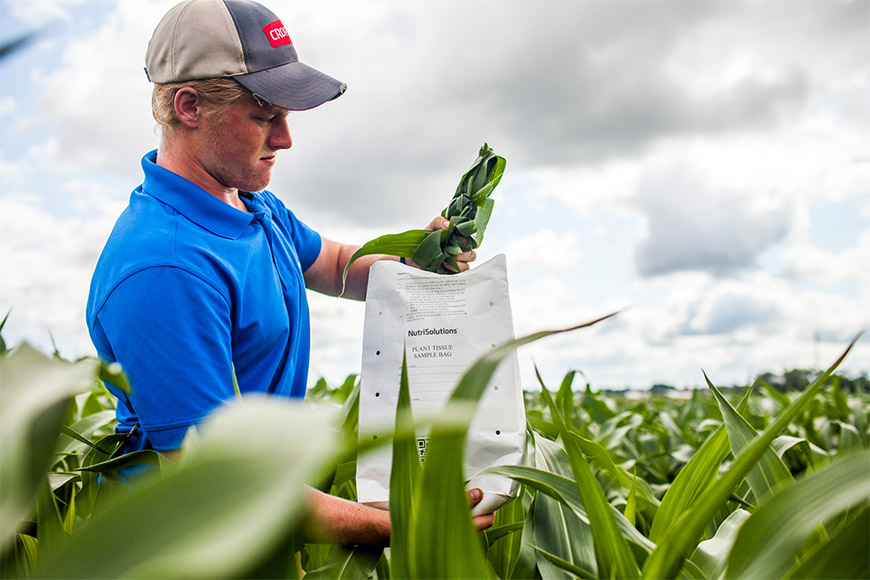Plan Now for Better Nutrient Management

If you’ve made tissue sampling a priority this season, you probably have a pretty good understanding of how your nutrient management program fared. You can use what you learned this season to develop a solid nutrient management strategy for next year. Proactive planning can help alleviate pressure when in-season challenges limit nutrient availability. Here are some tips to get started.
Identify nutrient uptake issues. Comparing nutrient levels in plant tissue with the nutrient levels in soil is a great way to understand how effective plant nutrient uptake is. In South Dakota, soils may test adequate for zinc, but tissue sampling will frequently reveal the micronutrient is deficient in the crop. This suggests the need for multiple forms of zinc that are delivered in a plant-available form. Knowing this, we can experiment with different fertilizer rates or formulations to help improve plant uptake.
Capitalize on top-end yield. With tissue sampling data, we can critically evaluate how to improve nutrient application, rate and formulation to increase uptake. For example, if tissue samples consistently show a nitrogen deficiency in V6 corn, your crops may benefit from a split nitrogen application. Adjusting nitrogen application timing could be just what your hybrids need to reach their high-end yield potential.
Identify management zones. Using technology such as the R7® Tool, you’re better able to identify areas with varying productivity potential and manage those areas independently. You can take tissue and soil samples from different areas to gain a better understanding for why each zone has high or low yield potential. From there, your agronomist can assist in developing site-specific fertilizer recommendations to address each zone’s nutrient issues.
Build a better plan. Many nutrients, such as phosphorus and potassium, have a limited ability to be corrected in-season once deficiencies occur. Using historical data, we can proactively build better nutrient management plans to limit the risk of deficiencies in-season.
Tissue sampling is a great way to boost your operation’s productivity and save on input costs. While this season is still fresh in your mind, take advantage of the opportunity to revisit your 2018 tissue sampling results to begin building a solid nutrient management foundation for 2019. You’ll likely find ways to increase productivity and potentially cut input costs by using a critical eye to analyze data.
To learn more about how to use tissue sampling to build a better nutrient management plan, contact your local WinField United retailer.
Identify nutrient uptake issues. Comparing nutrient levels in plant tissue with the nutrient levels in soil is a great way to understand how effective plant nutrient uptake is. In South Dakota, soils may test adequate for zinc, but tissue sampling will frequently reveal the micronutrient is deficient in the crop. This suggests the need for multiple forms of zinc that are delivered in a plant-available form. Knowing this, we can experiment with different fertilizer rates or formulations to help improve plant uptake.
Capitalize on top-end yield. With tissue sampling data, we can critically evaluate how to improve nutrient application, rate and formulation to increase uptake. For example, if tissue samples consistently show a nitrogen deficiency in V6 corn, your crops may benefit from a split nitrogen application. Adjusting nitrogen application timing could be just what your hybrids need to reach their high-end yield potential.
Identify management zones. Using technology such as the R7® Tool, you’re better able to identify areas with varying productivity potential and manage those areas independently. You can take tissue and soil samples from different areas to gain a better understanding for why each zone has high or low yield potential. From there, your agronomist can assist in developing site-specific fertilizer recommendations to address each zone’s nutrient issues.
Build a better plan. Many nutrients, such as phosphorus and potassium, have a limited ability to be corrected in-season once deficiencies occur. Using historical data, we can proactively build better nutrient management plans to limit the risk of deficiencies in-season.
Tissue sampling is a great way to boost your operation’s productivity and save on input costs. While this season is still fresh in your mind, take advantage of the opportunity to revisit your 2018 tissue sampling results to begin building a solid nutrient management foundation for 2019. You’ll likely find ways to increase productivity and potentially cut input costs by using a critical eye to analyze data.
To learn more about how to use tissue sampling to build a better nutrient management plan, contact your local WinField United retailer.

